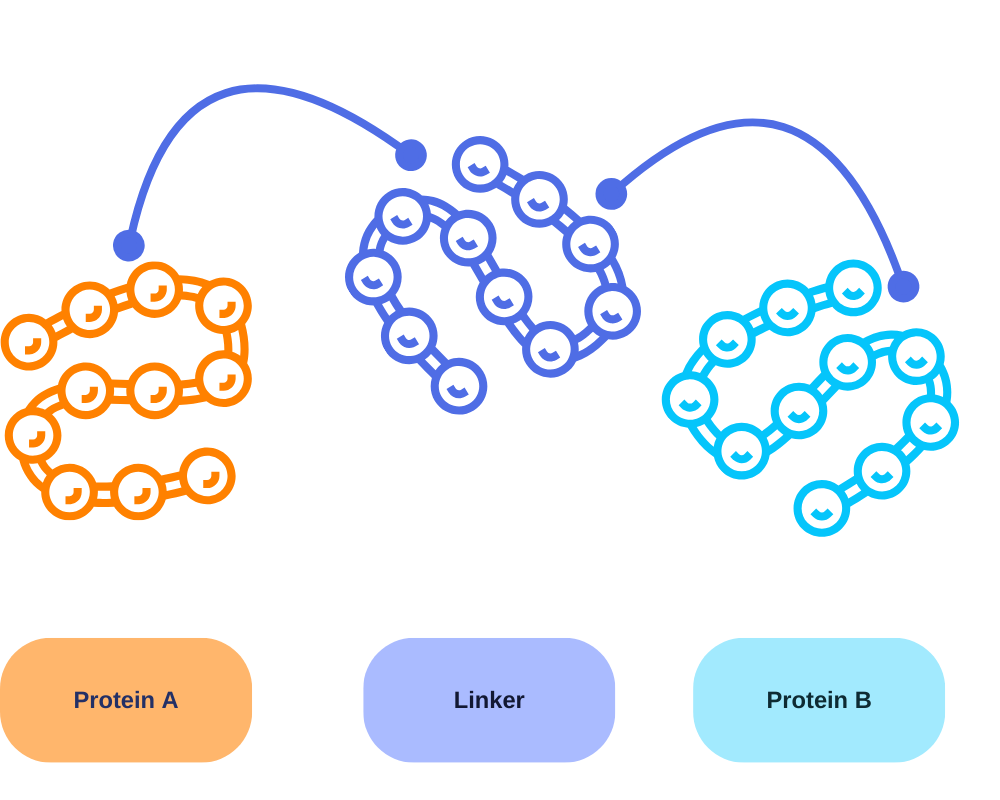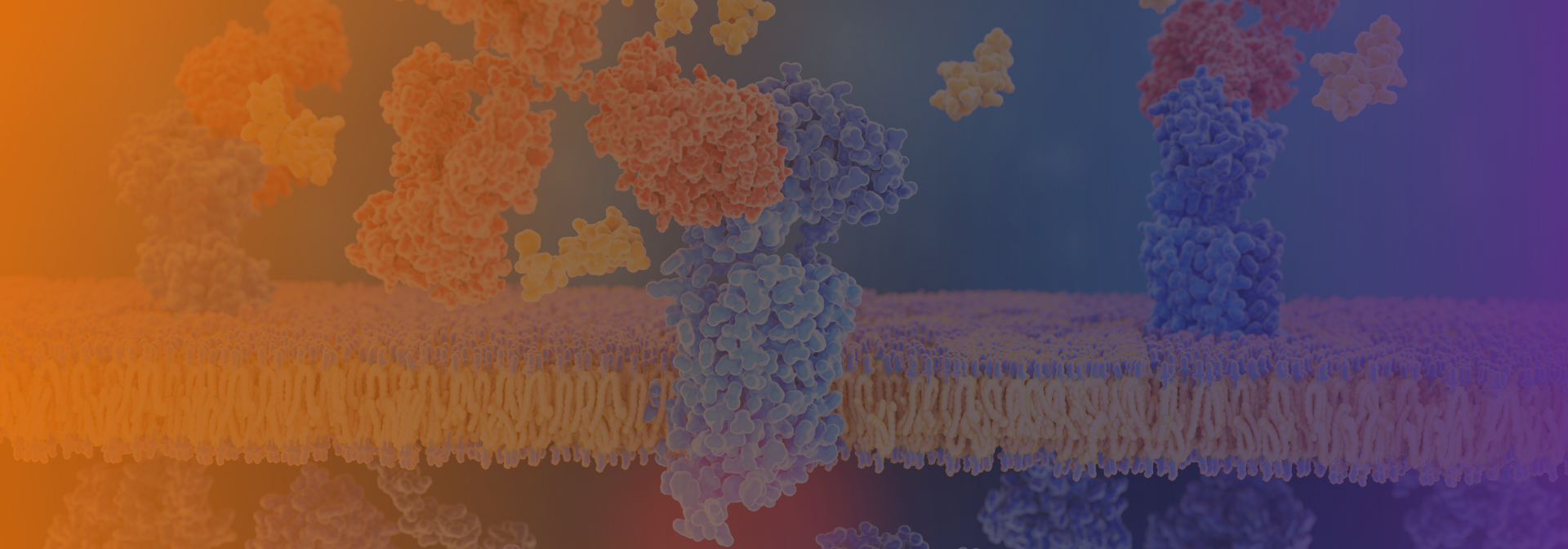What is a Protein Linker?
Abstract:
In this article, we will be exploring and addressing fundamental questions regarding protein linkers. We will navigate the topic of protein linkers with regard to design, properties, applications, and emerging trends in research, catering to researchers, academia, and the commercial biopharmaceutical sector.
Introduction: What is a Protein Linker?
Protein linkers are sequences of amino acids within a polypeptide chain that connect distinct protein domains. These linkers lack a defined secondary structure, often adopting random coil configurations, providing flexibility crucial for the overall protein's structure and function. The amino acid composition influences properties like flexibility and rigidity, with amino acids such as glycine, serine, and proline contributing to conformational freedom. Cleavable linkers may incorporate specific amino acid sequences recognized by proteolytic enzymes, allowing controlled separation of linked domains. The molecular design of protein linkers is pivotal in tailoring their function, impacting diverse applications in protein engineering.

In simpler terms, protein linkers serve as crucial connectors between different protein domains. In essence, they are flexible segments that tether functional units, influencing the overall structure and function of the resulting protein construct. This article aims to describe the significance of protein linkers and provide a comprehensive understanding of their diverse aspects.
Protein linkers play a pivotal role in various biological and biotechnological applications. Their importance lies in facilitating the construction of fusion proteins, influencing the stability and activity of engineered proteins, and enabling the development of advanced biosensors and nano-materials.
Conformational Types of Protein Linkers:
The world of protein linkers is diverse, encompassing several types. Understanding the nuances of each type is crucial for effective protein engineering. Some of the fundamental types of protein linkers include:
- Rigid Protein Linkers.
- Flexible Protein Linkers
- Short Protein Linkers
- Long Protein Linkers
- Cleavable Protein Linkers
- Non-Cleavable Protein Linkers.
Specialized Types of Protein Linkers:
In the realm of protein engineering, specialized types of protein linkers extend beyond the traditional conformational model, offering diverse functionalities tailored to specific applications. This section explores various specialized linkers, each designed to fulfill unique roles in the intricate world of molecular engineering.
- Tethered Linkers
- Hinge Linkers
- Crosslinkers
- Cyclic Linkers
Membrane-Associated Linkers:
Membrane-associated linkers play crucial roles in maintaining structural integrity and facilitating communication between the extracellular environment and the cell's interior. This section explores diverse types of protein linkers that are intricately tied to cellular membranes, influencing various cellular processes.
- Cell Membrane Linkers
- Transmembrane Linkers
- Membrane-Binding Linkers
- Lipid-Anchored Linkers
Applications of Protein Linkers:
Protein linkers, acting as versatile connectors, play a vital role in various applications across scientific and biotechnological domains. From enabling multifunctional proteins in fusion protein engineering to contributing to targeted drug delivery in therapeutic protein development, protein linkers shape innovative advancements. This section explores key applications where protein linkers are instrumental.
Fusion Protein Engineering:
- Seamlessly integrates different functionalities within a single protein construct, enabling multifunctionality and novel functionalities.
Therapeutic Protein Development:
- Enhances protein stability and enables targeted drug delivery, fostering advancements in therapeutic applications.
Biosensor Creation:
- Optimizes sensitivity and specificity, crucial for precise detection mechanisms in biosensor technologies.
Nano-material Design:
- Plays a pivotal role in directing assembly and functionality, influencing the design and properties of nanomaterials.
Other Applications Worth Noting:
- Protein linkers find additional applications in enzyme engineering, vaccine development, cell signaling studies, and drug delivery systems. Protein linkers continue to prove themselves invaluable in various scientific and biotechnological pursuits, with ongoing exploration uncovering new and diverse applications.
As molecular architects, protein linkers continue to shape the landscape of biotechnological applications, contributing to the development of novel therapeutics, advanced biosensors, and tailored nanomaterials. Their versatility remains a driving force in the ongoing exploration of innovative solutions across diverse scientific endeavors.
Protein Linker Design:
Designing an effective protein linker requires careful design considerations, and attention to computational and experimental methods employed in the process.
Protein Linker Design Considerations (Properties):
Crafting effective protein linkers comes with important design considerations, each shaping the functionality of these molecular connectors. Important properties to consider include:
Flexibility vs. Rigidity:
- Achieving a balanced flexibility and rigidity influences the overall structure of linked protein domains. This involves selecting amino acids with specific properties to achieve the desired structural characteristics.
Optimal Length:
- Linker length optimization ensures the desired spatial arrangement between functional units.
- Short Linkers (5-10 amino acids): Ideal for close proximity applications, minimizing unnecessary spacing for efficient interactions.
- Medium Linkers (15-20 amino acids): Balances flexibility and separation, suitable for moderate spatial distance between protein domains.
- Long Linkers (25-30 amino acids or more): Optimal for extensive spatial separation, providing significant flexibility for large constructs or dynamic conformational changes.
Cleavability:
- Cleavable linkers allow controlled separation of domains, offering flexibility in protein functionality.
Minimizing Immunogenicity:
- Designing linkers to minimize immunogenicity avoids triggering unwanted immune responses.
Solubility:
- Addressing solubility concerns ensures the fusion protein remains soluble in the intended environment.
-
Computational and Experimental Methods:
The design of protein linkers involves both computational and experimental methods. Computational tools enable predictive modeling, offering insights into the linker's behavior, while experimental methods validate these predictions, ensuring the designed linkers meet the desired criteria.
Molecular Dynamics Simulations:
- Predicts dynamic behavior by simulating atom movements, offering insights into the linker's flexibility and interactions.
Bioinformatics Tools:
- Analyzes amino acid sequences, predicting linker properties to inform design decisions efficiently.
X-ray Crystallography:
- Determines 3D structure, providing high-resolution insights into the spatial arrangement of protein linkers.
Nuclear Magnetic Resonance (NMR) Spectroscopy:
- Analyzes conformational flexibility and dynamics of protein linkers in solution using nuclear spin properties.
Mass Spectrometry:
- Characterizes protein mass and composition, aiding identification and validation of linker sequences and modifications.
Site-Directed Mutagenesis:
- Selectively alters amino acids to study their impact on linker properties and overall protein functionality.
Other Techniques:
- These are fundamental, common methods used in the design and analysis of protein linkers. Additional techniques may be used depending on the specific goals and the complexity of the protein engineering project
These combined computational and experimental methods offer a holistic approach to protein linker design, integrating predictive modeling with empirical validation for more effective and tailored outcomes.
Emerging Trends in Protein Linker Research
In the dynamic field of protein engineering, emerging trends are transforming the role of protein linkers. Machine learning applications streamline linker design, predicting and optimizing properties efficiently. Novel linker types offer innovative structural possibilities, broadening the scope of protein engineering. Exploring new frontiers like gene editing and metabolic engineering reflects the evolving versatility of protein linkers in cutting-edge biotechnology. These trends signify a shift towards more sophisticated approaches, propelling protein linkers into exciting and uncharted territories.
Conclusion:
Understanding protein linkers is essential for researchers and professionals in bio-pharmaceutical fields. By exploring their design, properties, and applications, this article aims to serve as a comprehensive resource for those seeking clarity on the intricacies of protein linkers.
If you’d like to learn more about protein linkers, have specific questions, or would like to work with us on a project - reach out to us!
Precision delivery of drugs to disease sites. By combining therapeutic agents with targeting domains, Fusion Proteins can enhance drug delivery to specific tissues or cells, reducing side effects and improving treatment outcomes.

kbDNA, INC.
125 Cambridgepark Dr.
Cambridge, MA 02140
Company
Contact Us
Phone:
+1 (781) 206-2235
Fax:
+1 (781) 206-2258
Email:
info@kbDNA.com
Useful Links
The kbDNA Inc. Quality Management Network is certified as conforming to ISO 9001:2015 standard. Request Certificate











